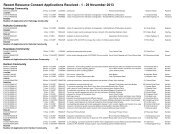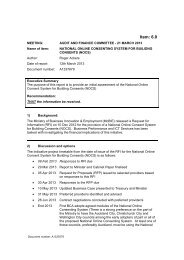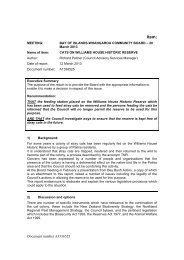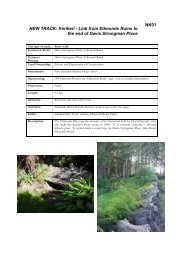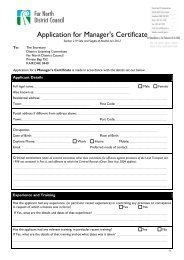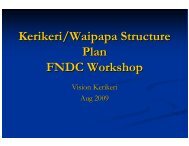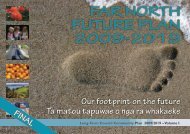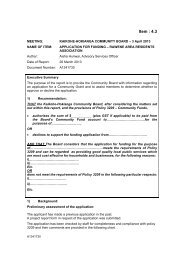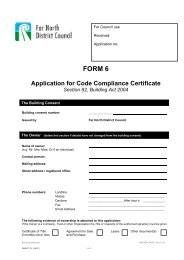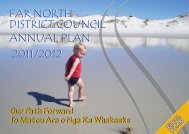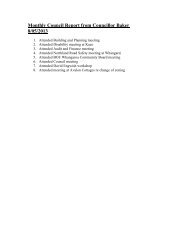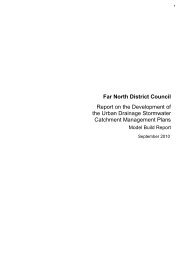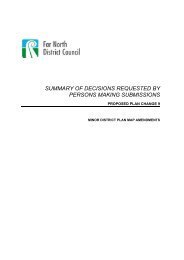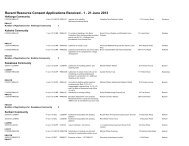Tangata Whenua - Far North District Council
Tangata Whenua - Far North District Council
Tangata Whenua - Far North District Council
You also want an ePaper? Increase the reach of your titles
YUMPU automatically turns print PDFs into web optimized ePapers that Google loves.
<strong>Tangata</strong> <strong>Whenua</strong>Values and PerspectivesPublication of the <strong>Far</strong> <strong>North</strong> <strong>District</strong> <strong>Council</strong><strong>District</strong> PlanWhakamaua te kahukiwiKarapotia o pokowhiwhiKia rangona te mahanaE te ngakau koingo(translated)“Wrap yourself in the kiwi cloakSo that your yearning heartMay feel its warmth”<strong>Far</strong> <strong>North</strong> <strong>District</strong> <strong>Council</strong> 2004
IntroductionThis document has been prepared to assist those who seek information on tangata whenuavalues and perspectives.We are all aware that the Treaty of Waitangi was signed here in our <strong>District</strong> some 160 yearsago. In the <strong>Far</strong> <strong>North</strong>, Maori comprise almost half of our resident population. Both thesematters underpin the need to understand tangata whenua values and perspectives so thatwe can move forward together.Politics is a matter of making choices. Mine is to foster communities throughout this districtthat celebrate diversity, and work together to make a better future.I do not adhere to the politics of conflict and division. I believe that leadership is aboutbringing people together.I believe that local bodies have a major role to play. Here relationships between differentcommunities and the individuals within them are built one meeting at a time. One newcitizenship ceremony, one political hui, one collective decision, one at a time. Here is wherethe tangata whenua values and perspectives and the principles of the Treaty of Waitangimeet the reality of flesh and blood.In the almost six years that I have been Mayor, it has been a pleasure to see the <strong>Far</strong> <strong>North</strong><strong>District</strong> <strong>Council</strong> improve its relationships with Maori. Our latest initiative is to join with theRunanga leaders of the <strong>District</strong>, to take an even more encompassing view of the issues thateffect and concern us all. <strong>Council</strong> is committed to fostering stronger relationships withMaori over the years ahead. The aim here is to work cooperatively with those who have theshared vision of progressing this unique district that we live in.I believe that we should work in partnership to secure a legacy that includes a safe,prosperous and environmentally pristine future for our children, our grandchildren andgenerations beyond.What we have before us as citizens of today, is the responsibility to change the words todeeds and to live our lives in accordance with those commitments. The strength in thefuture is not in disunity and division. Our strength is in working collectively to provide thatlegacy for those who come after us.Let us use today to map that path for the future.Yvonne SharpMAYORMayor Yvonne Sharp sharing fun and shelter1
Introduction: (continued)E nga rangatira ma e noho mai nei i nga waahi ataahua no teTakiwa Rohe o Te Raki, tena ra koutou katoa.My greetings to everyone who lives in this wonderful district of the<strong>Far</strong> <strong>North</strong>.Leatrice WelshIn the 1990’s I was privileged to work with Leatrice Welsh, an amazingly gifted Maoriwoman who was the convenor of the Resource Management Committee of Te Kotahitangao Te Tai Tokerau for almost 10 years, and who was tragically taken from us in May 2002.Her name for this committee was “Te Komiti Whakahaere Taonga Tuku Iho o TeKotahitanga o Te Tai Tokerau” which was far more expressive of its intrinsic purpose,because it identified all the resources of the environment as an ancestral heritage that wewho live here must treasure and protect so that our future generations would indeed inheritthe earth. It was established, in anticipation of the requirement as written into theResource Management Act 1991, to facilitate the consultation between local governmentand Maori. Under Leatrice’s dedicated management it served the planning processes ofboth regional and district local bodies well. Always its underlying purpose however was notonly to ensure that tangata whenua were the point of consultation but also to educate localgovernment of the Maori world view of the environment within the cultural context ofMaoritanga.This booklet records for posterity the ideals of traditional beliefs and practices that LeatriceWelsh and others of that era wrote and spoke about so eloquently in both reo.These are the words of one of our most renowned leaders of the <strong>Far</strong> <strong>North</strong>, the lateSir Kingi Ihaka.“Ki te toitu te kupu, ara te reo Maori,Ki te toitu te mana o te iwi MaoriKi te toitu te whenua, ka mau te Maoritanga.Otira me penei –Ki te ngaro te reo Maori, Ki te ngaro nga whenua Maori, -ka ngaro te mana Maori.Without the language, without prestige and without land, Maoritanga will cease to exist.These three: language, prestige and land, are the life of Maoritanga.” (Te Aou Hou 1957)These three are the underlying principles of this booklet:- to present Te Tiriti o Waitangi andall the information pertaining to tangata whenua in both reo; to acknowledge our sharedprestige and responsibility for the land; and to demonstrate respect for the cultural andtraditional values of Maoritanga. In a district such as ours where Maori are a significantproportion of the total population, it will provide a valuable contribution to our futurerelationships as people working together in a diverse and vibrantcommunity to protect our natural environment, - nga taonga tuku iho.Tihei mauriora!Naku noa , NaGloria HerbertCHAIRPERSON, TE RUNANGA O TE RARAWAGloria Herbert2
Te Tiriti O WaitangiMaori version as signed by Chiefs - Translated from the English by Henry WilliamKo Wikitoria te Kuini o Ingarani i tana mahara atawai ki nga Rangatira me nga Hapu o NuTirani i tana hiahia hoki kia tohungia ki a ratou o ratou rangatiratanga me to ratou wenua, akai mau tonu hoki te Rongo ki a ratou me te Atanoho hoki kua wakaaro ia he mea tika kiatukua mai tetahi Rangatira—hei kai wakarite ki nga <strong>Tangata</strong> maori o Nu Tirani—kiawakaaetia e nga Rangatira maori te Kawanatanga o te Kuini ki nga wahikatoa o te Wenuanei me nga Motu—na te mea hoki he tokomaha ke nga tangata o tona Iwi Kua noho ki teneiwhenua, a e haere mai nei.Na ko to Kuini e hiahia ana kia wakaritea te Kawanatanga kia kaua ai nga kino e puta mai kite tangata Maori ki to Pakeha e noho ture kore ana.Na, kua pai te Kuini kia tukua a hau a Wiremu Hopihona he Kapitana i te Roiara Nawi heiKawana mo nga wahi katoa o Nu Tirani e tukua aiane, amoa atu ki te Kuini, e mea atu anaia ki nga Rangatira o te wakaminenga o nga hapu o Nu Tirani me era Rangatira atu eneiture ka korerotia nei.Ko te tuatahiKo nga Rangatira o te Whakaminenga me nga Rangatira katoa hoki kihai I uru ki tauawhakaminenga ka tuku rawa atu ki to Kuini o Ingarani ake tonu atu te Kawanatanga katoaoo ratou whenua.Ko te tuaruaKo te Kuini o Ingarani ka whakarite ka whakaae ki nga Rangatira ki nga hapu ki nga tangatakatoa o Niu Tireni te tino rangatiratanga o o ratou whenua o ratou kainga me o ratou taongakatoa. Otiia ko nga Rangitira o te Whakaminenga me nga Rangatira katoa atu ka tuku ki teKuini te hokonga o era wahi whenua e pai ai te tangata nona te whenua ki te ritenga o teutu e whakaritea ai e ratou ko te kai hoko e meatia nei e te Kuini hei kai hoko mona.Ko te tuatoruHei whakaritenga mai hoki tenei mo te whakaaetanga ki te Kawanatanga o te Kuini. Kotiakina e te Kuini o Ingarani nga tangata Maori katoa o Niu Tireni ka tukua ki a ratou ngatikanga katoa rite tahi ki ana mea ki nga tangata o Ingarani.3
<strong>Tangata</strong> <strong>Whenua</strong>The <strong>Far</strong> <strong>North</strong> <strong>District</strong> Plan seeks to involve the tangata whenua in the sustainablemanagement of natural and physical resources in ways which are appropriate and effective.The Resource Management Act requires that Maori values be recognised and provided for,particular regard be had to kaitiakitanga, and the principles of the Treaty of Waitangi takeninto account in the processes of sustainably managing natural and physical resources.Principles of Te Tiriti o WaitangiThe Resource Management Act requires <strong>Council</strong> to take into account the principles of TeTiriti O Waitangi (Treaty of Waitangi). The principles reflect the underlying importance ofthe Treaty as being the guiding document in the relationship between Maori and the Crown.The <strong>Council</strong> has statutory responsibilities in its role as an agent of the Crown to takeaccount of the principles of the Treaty when managing the natural and physical resources ofthe <strong>District</strong>.The principles are important because they express the essential elements of the Treaty inways which are relevant today. The principles derive from the Treaty and give practicalsubstance to it. The Court of Appeal has defined these principles (New Zealand Maori<strong>Council</strong> v Attorney General (1987) 1.N.Z.L.R.) noting that they must be capable ofadaptation to new and changing circumstances and consequently additional principles maybe developed and existing principles redefined over time.The <strong>Council</strong> endorses the following principles as being a current reflection of the purposeand intent of Te Tiriti O Waitangi (Treaty of Waitangi), as interpreted by the Courts, that arerelevant to the sustainable management of natural and physical resources.6
The Principle of KawanatangaThe first Article of the Treaty gives expression to the right of the Crown to make laws and itsobligation to govern in accordance with constitutional process. This sovereignty is qualifiedby the promise to accord the Maori interests specified in the second Article an appropriatepriority. The Court of Appeal has noted that the principles of the Treaty do not authoriseunreasonable restrictions on the right of a duly elected Government to follow its chosen policy.Under the Resource Management Act, the delegation of resource management powersto local authorities means that those authorities can set objectives, make policies and makerules affecting the sustainable management of natural and physical resources subject tosatisfying sections of the Resource Management Act.The Principle of RangatiratangaThe second Article of the Treaty guarantees to iwi Maori the controland enjoyment of those resources and taonga which it is their wish toretain. The preservation of a resource base, restoration of iwiself-management, and the active protection of taonga, both materialand cultural, are necessary elements of the Crown’s policy ofrecognising rangatiratanga. Rangatiratanga is full chiefly authorityover resources including lands, forests, fisheries and other taonga.Rangatiratanga also includes elements of management, control andtribal self-regulation of resources in accordance with their owncustomary preferences.The Principle of PartnershipThe Treaty signified a partnership between Maori tribes and the Crown. The exchange ofpromises under Articles I and II of the Treaty is seen as an exchange of gifts: the gift of theright to make laws and the promise to do so, so as to accord the Maori interest an appropriatepriority. The principles of the Treaty require the Treaty partners to act toward eachother reasonably and with the utmost good faith. Reasonable co-operation and compromisethrough effective, early and meaningful consultation by both partners are also fundamentalto this concept of a partnership.7
The Principle of Active ProtectionThe guarantee of rangatiratanga given in Article II is consistent with an obligation to activelyprotect Maori interests and values in their lands, water, waahi tapu and other taonga, to thefullest extent practicable, and to give a priority to these when they may be adversely affected.In the context of resource management, the various elements which underlie andare fundamental to the spiritual association of Maori with the environment may be describedas taonga that have been retained by Maori in accordance with Article II of the Treaty. Theprinciple of active protection therefore extends to the cultural and traditional values and beliefsof Maori.The Principle of Hapu/Iwi ResourceDevelopmentArticle III of the Treaty gave to Maori the same rights and duties as other New Zealand citizens.The Treaty guaranteed to Maori retention of their property rights under Article II, andthe choice of developing those rights under Article III. To Maori, the efficient use and developmentof what are in many ways currently under-utilised hapu/iwi resources is a very importantprinciple of the Treaty in the context of the Resource Management Act. The Treatyrecognises the right of Maori to develop those resources in accordance with their ownneeds and aspirations. Recognition of the ability and need for hapu/iwi to develop their resourcesin a manner which achieves the purposes of the Resource Management Act is afundamental principle embodied in the Treaty.8
<strong>Tangata</strong> <strong>Whenua</strong> o ia Takiwaof each area within the <strong>District</strong>Ko te tangata whenua o ia takiwa nga tangata whai mana ki te whenua e nohohia e ratoume nga iwi, hapu, whanau, ahi kaa ranei i roto i nga whakapapa e hono atu ana ki tauawhenua me ona taonga katoa.The tangata whenua of the district are those people who have mana whenua over the land,based on the continuous occupation of an area by the relevant whanau/hapu/iwi (includingahi-kaa) and their genealogical ties to land and all natural resources.9
Nga Tikanga me te Tirohanga o nga<strong>Tangata</strong> <strong>Whenua</strong>This explanatory section, provided by tangata whenua, describes the traditional values andperspectives of tangata whenua. These values and perspectives reflect the predominantlyspiritual and communal nature of the Maori view of the world. The description of the valuesand perspectives provides a context for the subsequent sections of this chapter.The matters discussed in this section help to inform people about the possible effect ofdevelopment on tangata whenua values and perspectives and therefore enable moreinformed decisions to be made in respect of development proposals. This is consistent withthe duties imposed by Part II of the Resource Management Act.Ka nui te whanui te titiro a te tangata whenua i te ahua o te whakahaere o te taiao me ngahua o Papatuanuku. Ko enei nga mea i heke iho i nga tupuna, ma tatou e tiaki kei roto inga whakapapa e hono mai ana enei mea ki te tangata whenua me te ao whanui.Kei roto i nga korero tuku iho, Ranginui me Papatuanuku ka puta ko Tanemahuta,Tawhirimatea, Tangaroa, me etahi atu. Na enei tokorua i timata nga mea katoa o te ao ekiia nei ko a tatou taonga.E kitea atu ana, ko te mauri te mana nui, te kaihono i nga mea katoa. Engari ina mate temauri na te tukino, na te haaparu ranei, kua mate katoa a tatou taonga.Ki te Maori, ko te whenua te taonga, i puta mai te tangata i a ia, a te wa, ka hoki atu ano kireira. Ko te tino whakapono o te tangata whenua, ko nga tangata, no ratou te whenua ewatea ana ki a ratou nga hua o te whenua me nga mea katoa o te moana.E tino mohio ana te tangata whenua, i timata mai nga mea katoa i te whenua. Koia tenei kote taonga tino nui i tukua iho e nga tupuna ma tatou e tiaki. I te mea e puta mai ana te wai,me te oranga mo nga mea katoa i a ia, e tika ana ina te pau, te mutu ranei te mana o ngamea ki a tatou me whakahoki atu ano ki te whenua. No reira, te whakapono o te tangatawhenua, ko nga mea katoa kua huri hei otaota, kua pirau ranei, me whakahoki atu ki tewhenua anake.Ko nga rakau Maori, manumanu me nga kararehe o te ngahere, ko enei ko nga tamariki aTanemahuta, e kiia nei e te tangata whenua, ko te "Korowai O Papatuanuku", ko te mea nuikia mutu te whakawaatea i nga ngahere i te mata o te whenua, i te mea ka honoa tewhenua, ka horo te waipuke, ka takoto tahanga a Papatuanuku hei tirohanga ma te kanohitangata.10
Ko nga whakapai whenua, kaua rawa e pa ki nga ngahere, ahakoa inaniaei, kua mutu ke tekai o nga Maori i nga manu o te ngahere, hei oranga mo ratou, ahakoa ko ratou ano ngakaitiaki. Na ratou enei mea i tiaki mai i ora ai tatou. Te tino take a te tangata whenua, kiatiakihia nga ngahere me ana tamariki i te mea me hanga enei mea, e ora ai, me tiaki tetahi itetahi.Ko nga rongoa Maori he rongoa tuturu me tango mai i te Wao Nui a Tane. Tino ngakau nuite Maori ki enei rongoa mo te whakaora i nga mate tinana. E haere tahi ana nga kaikohirongoa me nga karakia hei awhina ki te whakaora i nga atua anake o te ngahere, engari,kia tino ma ai nga rongoa. Mai ano ka tango mai te Maori, kia rite te hiahia, ka waiho atuano etahi mo a muri atu. E tika ana kia mama te huarahi me nga tikanga mo nga Maori kienei rongoa tuku iho hei painga mo ratou. Ki te tangata whenua he taonga tino nui te wai ite tini o nga painga kei roto. Ko te whakapono o te Maori, kia ma te wai i nga wa katoa, kiaora ai nga manawa o nga uri kei te heke mai. He tini nga mahi mo te wai, he mea nui teneiki te tangata whenua. Ko te wai-ora mo te kai me te kohue rongoa, te iriiri tangata, me tehiki tapu whakwahi tangata turoro, me te tiaki i nga tuna, ika, me era atu o nga mea e nohoana i roto i te wai. Ko te wai kua waikura, kua waimate ranei, e kore e ora te mea ki roto.Mai ano i nga tupuna i haere ai nga tangata ki te hopu ika, ki te hopu tuna kei roto i nga awame nga roto. E tika ana e watea tonu ana te huarahi ki te tangata whenua ki te haere kienei wahi.Ki te tangata whenua, ko te hauora, te wai me te oneone, koia enei ko nga mea nui mo teTaiao, kaua e wehewehea engari me whakahaere tahi. Ko te pepeha a te Maori "Tiheimauri ora!" mo te pepi kua whanautia mai ki te ao ka tihewa, ka ngote, i te hauora ki roto itona manawa. Te whakamaramatanga o tenei pepeha e pa ana ki te hau ka ngoteatuatahitia e te pepi i tona putanga whanautanga mai ki tenei ao, a…tae noa ki tona hokingaatu ki te kopu o te whenua. Ki te tangata whenua, ko te atawhai i nga ngahere he mea tinonui, kia ora ai te ngahere.Wahi tapu. Ki te tangata whenua ka nui te whai mana, tapu ranei o nga hua oPapatuanuku. Engari, me tino titiro tatou ki nga urupa me etahi atu wahi penei, kia hikiarano te tapu katahi ano te tangata ka ahei ki te haere ki runga i enei wahi. Ko nga wahitapu he mea tino nui ki te Maori i raro i enei wahanga. Tena pea ko nga rakau, nga toka,maunga, tauranga waka, herenga waka, nga taonga mo te mahi kakahu me nga taongamahi. Enei mea katoa e taea e te tohunga te karakia te uta atu ranei e tapu ki runga kia roaai e whakamahia ana e tatou. I raro i nga tikanga Maori tuku iho he mahi tino kino ki te tutui te oneone o te wahi tapu, kei whiua te kaitutu me tana whanau e nga atua Maori, kehuaranei. Etahi atu wahi e tapu ana ko nga papakainga nohoanga rangatira, nga wahi pakangai hinga a ratou, nga Pa, me nga nohoanga taniwha.E kore rawa nga tangata e taea te hou atu ki roto ki enei wahi. Ki ta te Maori kua hara ngataurekareka e mahi keri ana ki roto i nga torere, ki te tapu o tena. Me ka mahia pena, kapatua ratou katoa e te riri o nga atua. Etahi maunga, puke, awa, e mohiotia ana he tapu keireira, e kore e takahia e te whenua, koia enei ko nga raina rohe i waenganui i nga iwi, ngahapu kia taea ai te whakaputa to ratou mana ki taua whenua. Ki nga tangata whenua, nuiatu te rangatiratanga o nga rohe ki te moana, me te mata kau o nga whenua. Ka korero temanu korero, ka korero i tona whakapapa, i tona maunga, i ona awa, kia kitea atu ai tehononga o tona hapu ki taua whenua. E mohiotia ana he tapu kei nga maunga me ngapuke, i nga mahi i mahia ki enei wahi i mua.11
He wahi huna nga torere kia kore ai e kitea atu e te kanohi tutu. Ko enei wahi kei roto i ngaana, kei runga ranei i nga toka. I te wa nei e kore te tangata whenua ko te whakaatu keihea nga torere, te take, kei rawakehia nga koiwi me nga taonga a o tatou tupuna. Na etahio nga hapu me nga whanau i whiriwhiria hei kaitiaki mo enei wahi. I nga ra nei, kuawhakamumu haere nga tangata whenua ki te whakatu whanui, i o ratou urupa. Te take, inga ra o mua ka tahaengia nga taonga, ka haaparutia nga koiwi. Ko nga hapu me ngawhanau nga kaitiaki o enei wahi tapu. E kore te katoa e mohio kei hea nga wahi nei keiwhakaitingia te mana o nga kaitiaki.Te wehe i etahi whenua, me etahi atu tikanga, e kitea atu ana tenei ki a ratou tikanga, ki tetiaki i enei whenua hei painga mo te katoa. Ki o tatou tupuna te takutai me te moana kotahitonu. Kahore e rereketanga o tetahi i tetahi. He mea nui ki te tangata whenua, kia tika tewhakahaere, me te tiaki i te takutai, me te moana, hei whakakaha ake i a ratou taurangaika. E tika tuku iho kia watea nga huarahi ki nga Maori, ki te kohikohi i nga hua oPapatuanuku. E kohi kaimoana ana te tangata whenua, i roto i ona ake rohe. Kawhakaarahia nga mataitai e nga hapu e noho ana ki te taha moana, kia whai kai ai ratou menga whanaunga, e noho ana ki te whenua.Ko enei wahi e tiaki matapikohia ana e te tangata whenua. I enei ra, ko nga mataitai,kahore mo te kohi moni, engari, mo te whangai i nga tangata o nga marae. Ko te wero onga tangata whenua, kia whakawatea tonu mai nga huarahi katoa ki enei wahi. Ko tetaiapure, ko te wehe i tetahi wahi ma nga tangata o reira e tiaki. Ko te rahui e kati i tetahiwahi ki te tangata, kia tupu ai, kia hua ai nga kai moana kei reira.12
<strong>Tangata</strong> <strong>Whenua</strong> Values and PerspectivesInterpretation<strong>Tangata</strong> whenua have a holistic approach to the management of the environment and itsresources, and consider that all resources are treasures handed down to them as guardiansby their ancestors. Fundamental to this approach is the principle of interconnectiveness ofmankind to the natural world through whakapapa (genealogical ties).According to Maori traditions, Ranginui (Sky Father) and Papatuanuku (Earth Mother) arethe primeval parents who gave birth to Tanemahuta (God of the Forests), Tawhirimatea(God of the Winds), Tangaroa (God of the Seas) and many others. It is from this progenythat there came about the creation of the living world and all its inhabitants, otherwiseknown today as our natural resources.The holistic approach is based on the concept of “mauri” - the life force which links togetherall living things as one, without boundaries or division. Each resource has its own life forceto sustain its existence. Therefore should the mauri of a resource be extinguished by someform of desecration or pollution, the resource can no longer exist.The most valued resource to all Maori is the whenua (the land). The significance of whenuarelates back to Papatuanuku who is the source of all creation - from whom human beingswere created and nurtured and to whom human beings return. <strong>Tangata</strong> whenua believethat the people belong to the land and should be accorded freedom to enjoy the fruits of theland and the abundance of the sea.The land or the Earth is recognised by the tangata whenua as the Mother of creation, and isconsidered to be among the most important taonga (treasures) handed down for ourguardianship. She provides life for all living things from the waters within her and peopleare bound to respect her with the love that all children should give to their mother. From herlife is derived. To her, the wastes of life and the body devoid of life are returned. Hence thebelief by tangata whenua, that the only method of the disposal of waste is to the land.The children of Tanemahuta were the native forests, shrubs, bird-life, and forest animalswhich were perceived by tangata whenua as forming the “Te Korowai O Papatuanuku”, orthe cloak that covers Earth Mother. Therefore it is most important that the land not bestripped of its native trees. Such an act is seen by tangata whenua as an act of indecency,and it is painful to witness the aftermath of such actions in the form of slips, erosions andthe flooding of land where our Earth Mother must lie in her nudity for all to gaze upon.At no time should development of land endanger or threaten the natural habitat of nativebirds. Although Maori no longer depend on native species for sustenance, they are stillconsidered as kaitiaki that we recognise and protect for their past contributions to oursurvival. The protection of the forest and its children is of high priority to the tangatawhenua because each species was created to complement the other to ensure their mutualsurvival.Rongoa Maori (Maori medicine) were natural remedies obtained from Te Waonui o Tane(the great forests of Tane) which were highly valued for their healing and remedialproperties. A karakia (incantation) always accompanied the gathering, preparation andadministering of rongoa as a vital part of the healing process.13
The entire process of preparing rongoa was tapu, not only in respect of the gods whopresided over healing, but also for hygienic reasons. The longstanding practice of Maoriwas that you took only what you needed, so that there would always be some left foranother day. Access to rongoa and measures that allow for the continuance of traditionalcultural practices are vital for the well-being of Maori.Water has many values and is an equally important taonga to tangata whenua. Maoribelieve that water must remain pure and uncontaminated so that it may continue to protect,preserve and sustain life for future generations. Water has many different purposes orvalues to tangata whenua. “Waiora” has healing and life-giving properties, and is used forritual purposes. “Wai Maori” is for human consumption, for everyday purposes and tosustain the habitat of fresh water fisheries. “Waimate” or “Waikura” are stagnant or pollutedwaters which are no longer capable of sustaining life.The ability of tangata whenua to continue their longstanding traditional practices of fishingthe fresh-water rivers, lakes and streams for tuna (eel) is an important issue and, inparticular, the provision of access to these areas is desirable.Air, along with water and soil, is perceived by tangata whenua as an integral element of theenvironment. Together they must be managed as one rather than as separate entities. TheMaori pepeha “Tihei mauri ora!” signifies the “breath of life” and is an exclamation saying,“Thus, there is life!”.This pepeha (or proverb), relates to the time when a new-born baby enters into the worldand takes its first breath of “life”. The symbolism of the proverb encompasses theimportance of life and all that pertains to it. <strong>Tangata</strong> whenua believe therefore that air mustbe of the purest quality; a quality that will sustain the life of the new-born child intoadulthood and until such time as they depart this world.All resources are considered by tangata whenua to hold an element of sacredness and, inparticular, we look at the sacredness of “waahi tapu” and other sites of significance toMaori. Waahi tapu denotes a place under tapu (under restriction). Waahi tapu is apersonal thing which is sacrosanct to Maori.Included under this category could be trees, rocks, mountains, hills, waterways, places forfood gathering, cultivating and harvesting, canoe landings, moorings, and sources ofmaterials for the construction of houses, canoes and for clothing and tools. All these thingscould be placed under sacred protection by a tohunga (a spiritual expert) to maintain theintegrity of their sustainable use.Other sites of significance to tangata whenua often considered as tapu include papakaingawhere a chief may have lived, places where battles were fought and where the dead fell, thegreat pa sites of the district or the abode of a taniwha. There are some waahi tapu thatno-one can enter or touch. By Maori custom it was considered a direct violation of tapu to“turn the sod” or disturb the soil within the boundaries of a waahi tapu. To carry out this actwas to bring the wrath of the gods upon the offender and his family. Certain maunga(mountains), puke (hills) and awa (rivers) were also considered sacred and thereforeremained relatively untouched. These maunga and awa were significant to tangata whenuain that they marked the land boundaries where hapu/iwi exercised mana whenua.14
Their boundaries to the sea and the natural features of the landscape were a very importantpart of the landscape.Oratory often included the recital of one’s whakapapa (genealogy) which made reference toa mountain or a river to identify the affinity of the hapu with that land. Mountains and hillswere considered tapu because of these beliefs, and because of historical events which tookplace on them.Urupa, or burial grounds, were often located in areas that were hidden from prying eyes.These places of burial could be a cave (ana) or ledge in the rocks. To preserve theidentification of their whereabouts, their locations were known only to an appointed few ofthe hapu or whanau of a particular area and, in certain cases, to the wider iwi.Today there is a certain element of reluctance on the part of the tangata whenua to discloseor identify their waahi tapu due to past incidents of the pilfering of taonga from these burialgrounds, and the desecration of human remains. The guardians of these sacred places arethe hapu and whanau of the area and, in many instances, these hapu and whanau wish toretain their rangatiratanga (chiefly authority) as the guardians of their sacred places by notrevealing them to the public. The setting aside of reserves and land for special purposes isconsidered by tangata whenua as a practice consistent with their tikanga, in that itconserves those areas of special significance for the enjoyment of all.Traditionally, the entire coastal area was considered to be part of the whenua. Maori madeno distinction between the foreshore and the sea. The management of the coast and itsenvirons is a priority for tangata whenua and, in particular, the conservation andenhancement of their fisheries. The freedom of traditional access to the natural resourcesof the land and the sea was a customary right of the indigenous peoples of this land.The gathering of kai-moana (seafood) was carried out by tangata whenua within theirtraditional boundaries. Mataitai (traditional fisheries) were established by each hapu alongthe coast to provide them and their inland whanaunga (relatives) with food.These food gathering places were very jealously guarded and protected by the tangatawhenua of the area. Today mataitai provide for the needs of the marae and its people andare strictly for non-commercial purposes. Access to these customary food gathering placesis a priority of tangata whenua. “Taiapure” is a more recent form of reserve that involvesthe whole community. The concept of rahui is a means of establishing a reserve or arestricted area which is put in place as a conservation measure, to conserve the food that isthere and allow for its rejuvenation.15
ConclusionThis booklet has been prepared to assist people achieve a higher understanding of the particularposition Maori people occupy in the <strong>District</strong>. This needs to be seen in the context ofthe Maori values and belief system and not framed only in terms of constitution and statute.It is a guide to assist all members of our community, not only resource planners and landowners.It is also important to recognise that by virtue of genealogy and legal court decisions Maoridomicile remains connected to the land.While Maori people may choose to live where they wish for a variety of personal reasons,the overarching Iwi fabric supported by hapu is founded on that domiciliary factor. They stillretain that essential binding of genealogical connections and associations to their ancestralrights wherever they are located.These are basic factors that Local Government must acknowledge, recognise and give effectto across the broad spectrum of their policies.I commend this booklet in the expectation that it will assist all people, Maori included, to recogniseand give reciprocal extension of goodwill, freely expressed and respected.This booklet has no statutory power. The values of which it speaks, the principles of respectand goodwill, do not require that sort of power. Mutual respect and responsible attitudesare the building blocks of a better district and nation.The genealogical connections to certain places is the fundamental position Maori peopleoccupy within our <strong>District</strong>. That position, and the responsibilities it carries, has been formedthrough generations of association with the land and all the diverse resources of the <strong>Far</strong><strong>North</strong>. It is a position that is recognised and protected in the many statutes under whichlocal governance is delivered.“No te kaihanga ki nga Tupuna ka tukuna iho te Aroha; he tikanga tuturu mo te iwi Maori onaianei, hei tiaki I tona ake <strong>Whenua</strong> Motuhake”“Aroha from above; that which intertwines with all of those earthly values, is seen by Maorias one of God’s great gifts.”“Maori when practicing kaitiakitanga by utilising the principles and values of Aroha, maketheir gift back to God.”Na,John KlaricichDEPUTY MAYOR16



